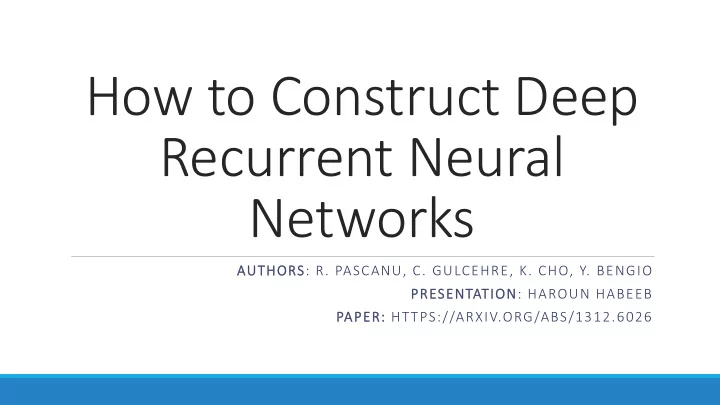

How to Construct Deep Recurrent Neural Networks AUTHORS: R. PASCANU, C. GULCEHRE, K. CHO, Y. BENGIO PRESENTATION: HAROUN HABEEB PAPER: HTTPS://ARXIV.ORG/ABS/1312.6026
This presentation Motivation Formal RNN paradigm Deep RNN designs Experiments Note on training Takeaways
Motivation: Better RNNs? Depth makes feedforward neural networks more expressive What about RNNS? How do you make them deep? Does depth help?
𝒊 𝑢 = 𝑔 ℎ (𝒚 𝑢 , 𝒊 𝑢−1 ) Conventional 𝒛 𝑢 = 𝑔 𝑝 𝒊 𝑢 RNNs Specifically: ℎ 𝒚 𝑢 , 𝒊 𝑢−1 ; 𝑿, 𝑽 = 𝜚 ℎ 𝑿 𝑈 𝒊 𝑢−1 + 𝑽 𝑼 𝒚 𝑢 𝑔 𝑝 𝒊 𝑢 ; 𝑾 = 𝜚 𝑝 (𝑾 𝑈 𝒊 𝑢 ) 𝑔 ▪ How general is this? ▪ How easy is it to represent an LSTM/GRU in this form? ▪ What about bias terms? ▪ How would you make an LSTM deep?
THE DEEPENING
𝒛 𝑢 = 𝑔 𝑝 𝒊 𝑢 DT(S)-RNN 𝒊 𝑢 = 𝑔 ℎ ( 𝒚 𝑢 , 𝒊 𝑢−1 , 𝒚 𝑢 , 𝒊 𝑢−1 ) Specifically: 𝑧 𝑢 = 𝜔(𝑋ℎ 𝑢 ) ℎ 𝑢 = 𝜚 𝑀 ( 𝑈 𝜚 𝑀−1 … 𝑊 𝑈 𝜚 1 𝑊 𝑈 ℎ 𝑢−1 + 𝑉𝑦 𝑢 𝑊 𝑀 2 1 + ഥ 𝑋 𝑈 ℎ 𝑢−1 +ഥ 𝑉 𝑈 𝑦 𝑢 )
𝒛 𝑢 = 𝑔 𝑝 𝒊 𝑢 DOT(S)-RNN 𝒊 𝑢 = 𝑔 ℎ ( 𝒚 𝑢 , 𝒊 𝑢−1 , 𝒚 𝑢 , 𝒊 𝑢−1 ) Specifically: 𝑈 𝜔 𝑀 (… 𝑋 𝑈 𝜔 1 𝑋 𝑈 ℎ 𝑢 ) 𝑧 𝑢 = 𝜔 0 (𝑋 𝑀 1 ℎ 𝑢 = 𝜚 𝑀 ( 𝑈 𝜚 𝑀−1 … 𝑊 𝑈 𝜚 1 𝑊 𝑈 ℎ 𝑢−1 + 𝑉𝑦 𝑢 𝑊 𝑀 2 1 + ഥ 𝑋 𝑈 ℎ 𝑢−1 +ഥ 𝑉 𝑈 𝑦 𝑢 )
0 = 𝒈 ℎ 0 (𝒚 𝑢 , 𝒊 𝑢−1 0 𝒊 𝑢 ) sRNN (𝑚) = 𝑔 (𝑚) (𝒊 𝑢 𝑚−1 , 𝒊 𝑢−1 𝑚 ∀𝑚 ∶ 𝒊 𝑢 ) ℎ (𝑀) 𝒛 𝑢 = 𝑔 𝑝 𝒊 𝑢 Specifically: (𝑀) 𝒛 𝑢 = 𝜔 𝑋 𝑈 𝒊 𝑢 (0) = 𝜚 0 (0) 𝑈 𝒚 𝑢 + 𝑋 𝑈 𝒊 𝑢−1 ℎ 𝑢 𝑉 0 0 𝑚 = 𝜚 𝑚 𝑚−1 + 𝑋 (𝑚) 𝑈 𝒊 𝑢 𝑈 𝒊 𝑢−1 ∀𝑚: 𝒊 𝑢 𝑉 𝑚 𝑚
Experiment 0: Parameter count Food for thought: Not clear which one has most number of parameters – sRNN or DOT(S)-RNN.
Experiment 1: Polyphonic Music Prediction Next Task: note(s) Sequence of musical notes Food for thought: Sure, depth helps, but * helps a lot more in this case. What about RNN* and other models with *?
Experiment 2: Language Modelling Next Task : Sequence of characters/words character/word (LM on PTB) Food for thought: Deepening LSTMs? Stack them or DOT(S) them?
Note on training ▪ Training RNNs can be hard because of vanishing/exploding gradients. ▪ Authors did a bunch of things: ▪ Clipped gradients, threshold = 1 ▪ Sparse weight matrices ( 𝑋 0 = 20 ) ▪ ⇒ max 𝑗,𝑘 𝑋 𝑗,𝑘 = 1 Normalized weight matrices ▪ Add gaussian noise to gradients ▪ Used dropout, maxout, 𝑀 𝑞 units
Takeaways ▪ Plain, shallow RNNs are not great. ▪ DOT-RNNs do well. Following should be deep networks ▪ 𝑧 = 𝑔(ℎ, 𝑦) ▪ ℎ 𝑢 = 𝑔 𝑦 𝑢 , ℎ 𝑢−1 , 𝑦 𝑢 , ℎ 𝑢−1 - both 𝑔 and ▪ Training can be really hard. ▪ Thresholding gradients, Dropout, maxout units are helpful/needed ▪ LSTMs are good Questions?
Recommend
More recommend